This week, we are very pleased to feature a guest post from Special Collections Reference Coordinator Regina Rush.
“…and they stopped in my vision and looked up at me like I had something…to tell or something that needed to be seen or they wanted something to be remembered. So I kinda get this sense that it is time to understand what it must have been like.”
–African-American genealogist Tonya Groomes,
in the documentary Slavery by Another Name
My pursuit for information about the Rush branch of my family began shortly after I began working in the Special Collections Library in the late nineties.
What I knew about my family’s history could be summed up on a notecard. My paternal grandfather’s name was James Neverson Rush; he married my grandmother, Roberta Brooks; and they raised eleven children in a place called Chestnut Grove, a small unincorporated community in Esmont, Virginia, nestled in the Green Mountains of Southern Albemarle County.
An initial conversation with my father helped fill in a few gaps, but certainly not enough to satisfy my curiosity. I learned that my paternal great grandmother’s name was Ella Rush, but beyond that he knew very little of the Rushes’ history. With my appetite sufficiently whetted and wanting to know MORE! MORE! MORE! I embarked on a genealogical quest to “meet” my people. As one genealogist has put it, “When you search for your ancestors, you find great friends.”
Well, not only did I find “great friends,” I found them under my feet at my job, one floor below in the stacks of the Albert and Shirley Small Special Collections Library: they were my great-great grandparents, Nicey Ann Coles and Isham Rush.
Here’s how it happened
One Saturday afternoon while visiting my Cousin Gloria, our conversation turned to the subject of our family’s history. After sharing various family anecdotes, I asked her, “Cousin Gloria, do you have any idea what slaveholder owned our family?” I’d been researching my family’s history for several years, and despite numerous conversations with family members, visits to historical societies, and searching various genealogical databases, this key piece of family lore continued to elude me. So imagine my shock and elation when she responded in her slow, sweet, quiet voice, “Honey, our people were owned by the Rives Family.”
THE RIVES FAMILY??!!
As in the, Special Collections holds numerous collections of this family’s papers, Rives Family? Over the course of the next several weeks, I painstakingly worked my way through collection after collection of Rives papers held at Special Collections. One day, while searching through the papers of a Rives named Robert, I happened upon a letter dated March 24, 1851 to Robert Rives from his sister-in-law, Maria, discussing a recent visit to his home, Oakland, and the declining health of his brother George. I quickly skimmed the contents of the first page and flipped it over. My eyes were immediately drawn to a list of thirty-four names written at the bottom of the page. Excitement slowly began to build in me. Almost afraid to breathe, I quickly scanned the list. PAYDIRT! Number 22 on the list was the name “Nicey.”
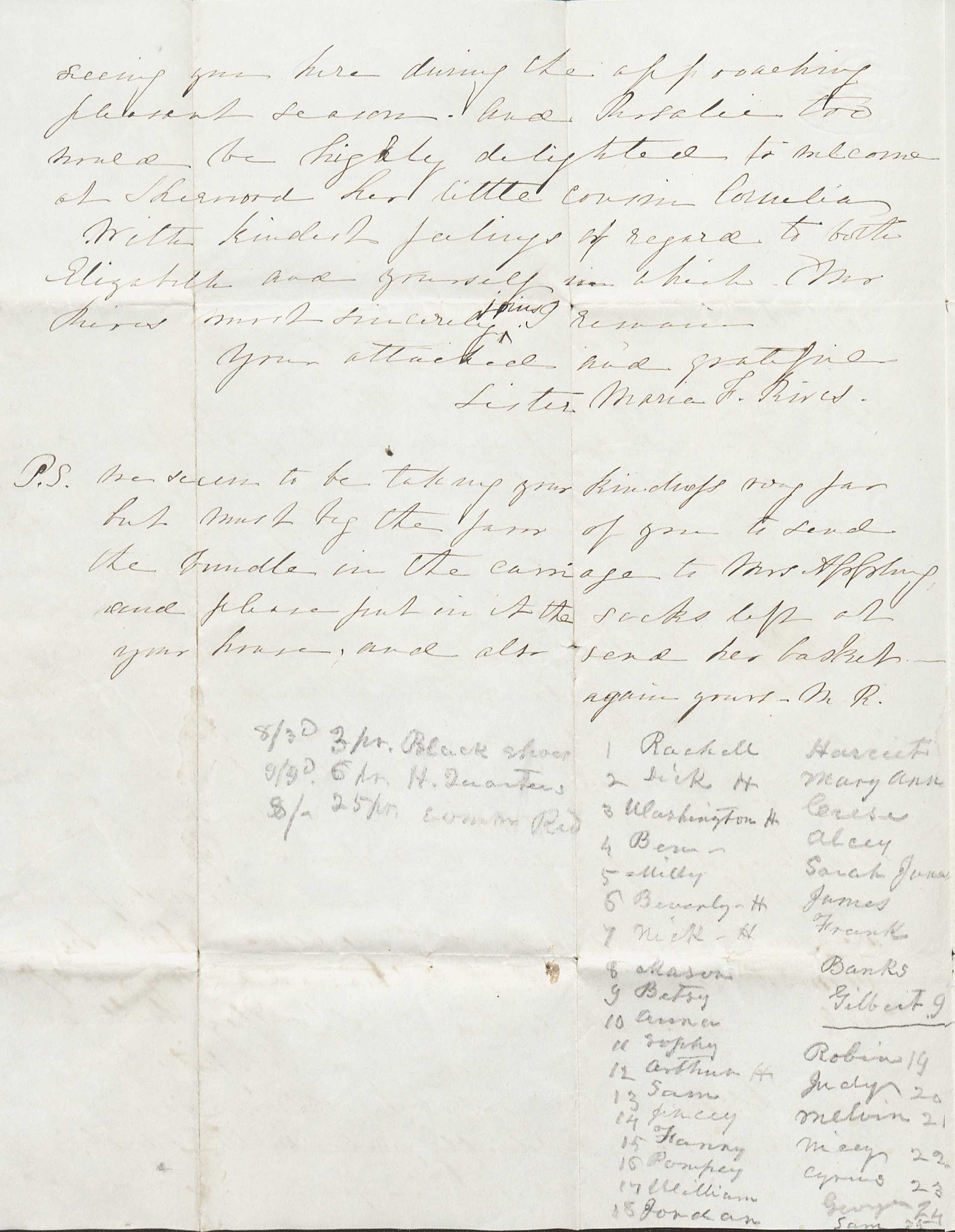
. In the letter Maria writes about a recent visit to Rives and his family at their home called Oakland, and the declining health of his brother George. The contents of the letter has no connection to the list found at the bottom of page two. Rives uses the bottom of the page as scratch paper to list the names of 34 of his slaves and supplies purchased for them. The number 22 on the list is my great-great grandmother, Nicey Ann Coles. (MSS 4289: March 24, 1851 letter from Maria Rives to her brother-in-law, Robert Rives Jr. Image by Regina Rush)
Uncovering the stories of Nicey Coles Rush and Isham Rush
Nicey Ann Coles was born circa 1823 in Nelson County, Virginia, most likely on one of the several plantations owned by Robert Rives, Sr. (1764-1845), a wealthy international merchant, who farmed tobacco and wheat, but most importantly owned both my great-grandparents. Nothing is known about Nicey’s parents. Information provided on her 1868 marriage license lists only her father’s last name, which is “Coles.” For reasons unknown, her mother’s name is not listed at all. In all likelihood, both she and her parents lived as slaves on Oak Ridge, the 2555 acre Nelson county, Virginia, estate owned by the Rives family. Oak Ridge was originally an 800-acre tract owned by Colonel William Cabell (1730-1798). Cabell later gave it as a gift to his daughter, Margaret Jordan Cabell, and his son-in-law, Robert Rives, Sr. (1764-1845).
Very little is known about Isham Rush, Nicey’s husband: his birth and death dates and parents’ names remain a mystery. Isham was possibly born enslaved on the Rives Plantation in South Warren, Albemarle County. Census records of his children confirm that Isham was a native Virginian. Three of his children record him as their father on their marriage licenses. By 1868, he disappears from public record. His oldest child was his namesake (spelled “Isom” in the 1870 census) and down through the generations some variation of the name continues to be used. Even today, more than a 150 years later, Isham remains in the family: one of my paternal uncles was named John Isom Rush.
How long Nicey lived and worked on the Rives’ plantation in Nelson is unclear. Records reveal that she was relocated at some point to one of the Rives’ Albemarle County plantations, referred to as the South Warren Estate. This estate was originally owned by Robert Rives Sr., but upon his death it passed on to his son Robert, Jr. (1798-1866). Robert, Jr. was born in Nelson County in 1798. He represented Nelson County in the House of Delegates during 1823-1829 and afterward moved to Albemarle County, eventually becoming one of the wealthiest men in Virginia before the Civil War. The 1860 census record his assets at $280,000; most of his wealth was lost during the Civil War.
Records reveal that my great-great grandparents had a longstanding relationship of more than 13 years on the South Warren Estate and managed to raise a family–as much as one could within the restrictive confines of slavery. Their children’s names were Ella (my great grandmother), Cecelia, Louisiana, Lucy, Isham, Neverson and Fleming. Some evidence suggest they had as many as ten children, but more research needs to be done before this can be confirmed. The Rush families of Chestnut Grove appear to be descended from two of their children, Ella and Louisiana Rush.
The following images were obtained from several plantation records of Robert Rives and provide brief snippets of information concerning Nicey and Isham’s existence at the South Warren Estate, in Warren Virginia.
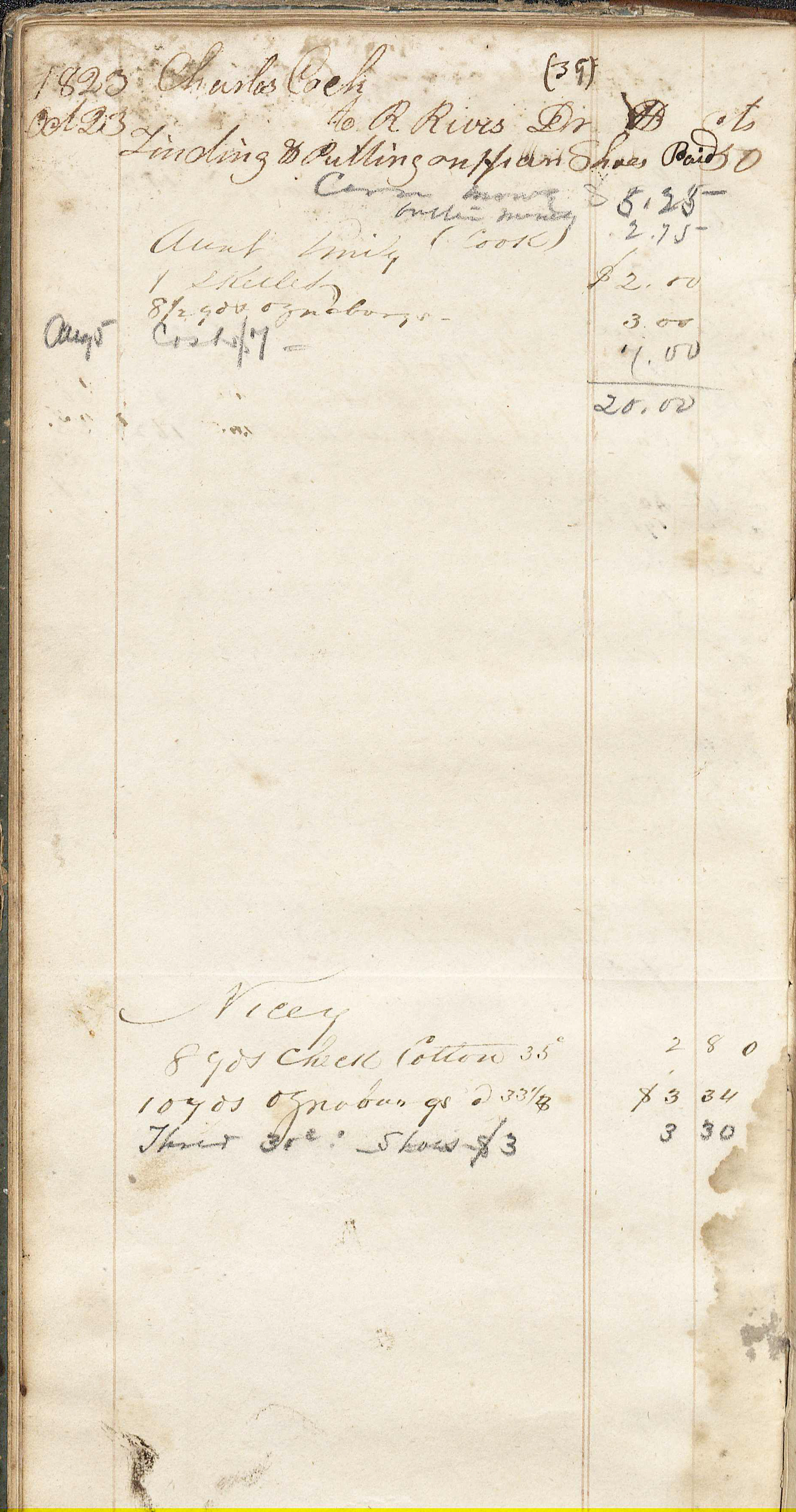
An account book held by the Special Collections Library shows that Rives purchased eight yards of check cotton and ten yards of Osnaburg fabric for Nicey for $6.14. On the opposite page of Nicey’s entry is written the name Isham and under the name, “suit of clothes $18.00” (see next image). While the page includes other entries as early as 1823, these entries likely date to the 1840s.
(MSS 4655: Robert Rives Blacksmith Shop Account Book, 1823; 1843-1846. Image by Regina Rush)
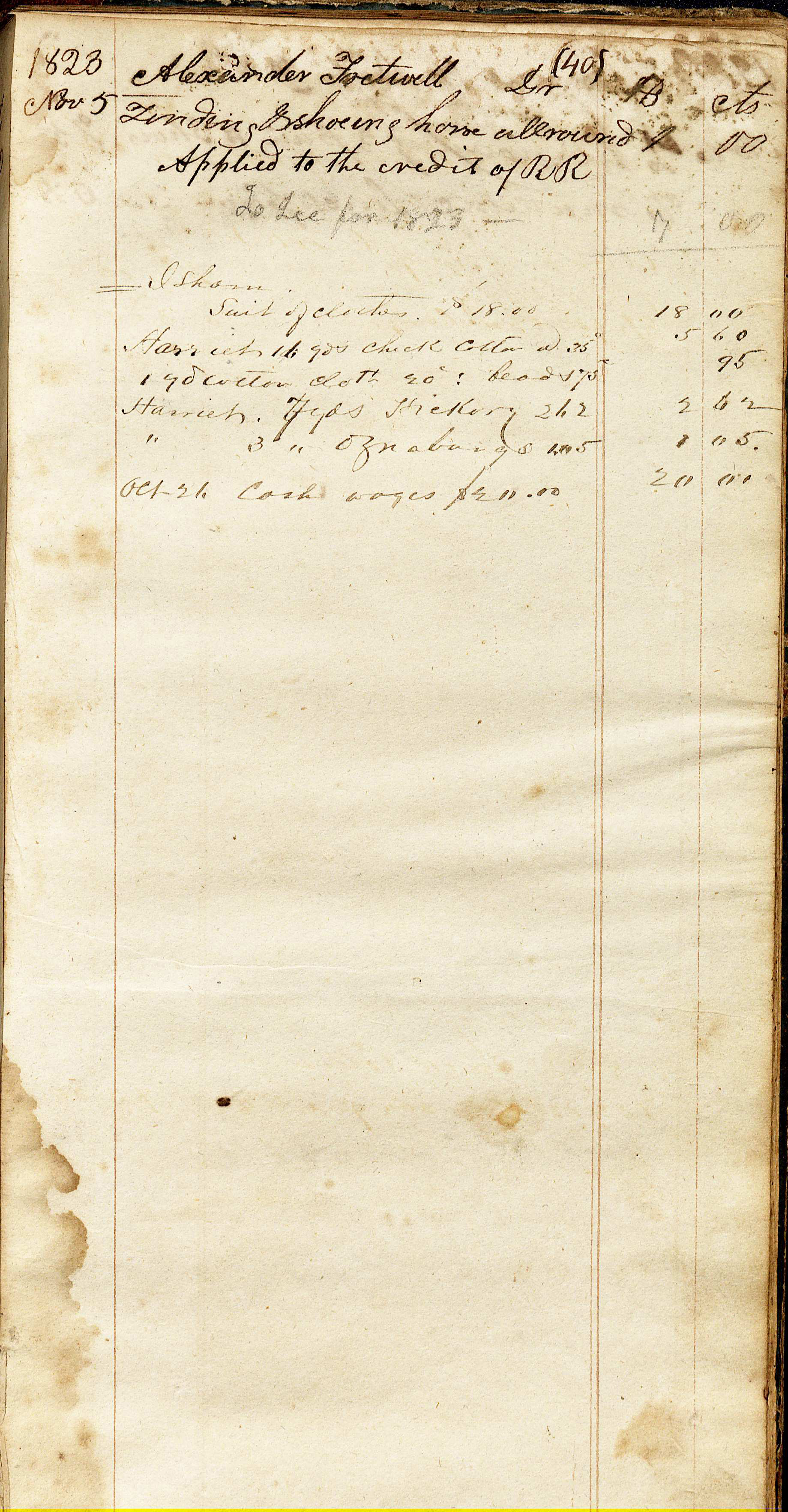
Opposite Nicey’s entry is written the name “Isham” and under the name “suit of clothes $18.00.” (Image by Regina Rush)
A discovery in Scottsville
Things got even more interesting when I contacted the Scottsville Museum, after discovering online that they had Rives-related papers. First, I found a relevant entry in a business ledger of Robert Rives, Jr., which is owned by the Scottsville Museum. It lists Rives’ purchase of shoes for some of his slaves. Among the names on the list are my great-great grandparents, Isham Rush and Nicey Ann Coles. It reads “Shause (Shoes) bought on South Warren Estate June 18, 1849 for the negroes, vis Cyrus, Ben, Robin, Isham, Melvin, Daniel, Washington, Jurdan, Nick, Sophy, Nicey, Jincey, Bevly.” (Robert Rives Ledger 1846-1863. Page 12, Image 8, Scottsville Museum, Scottsville, Virgina).
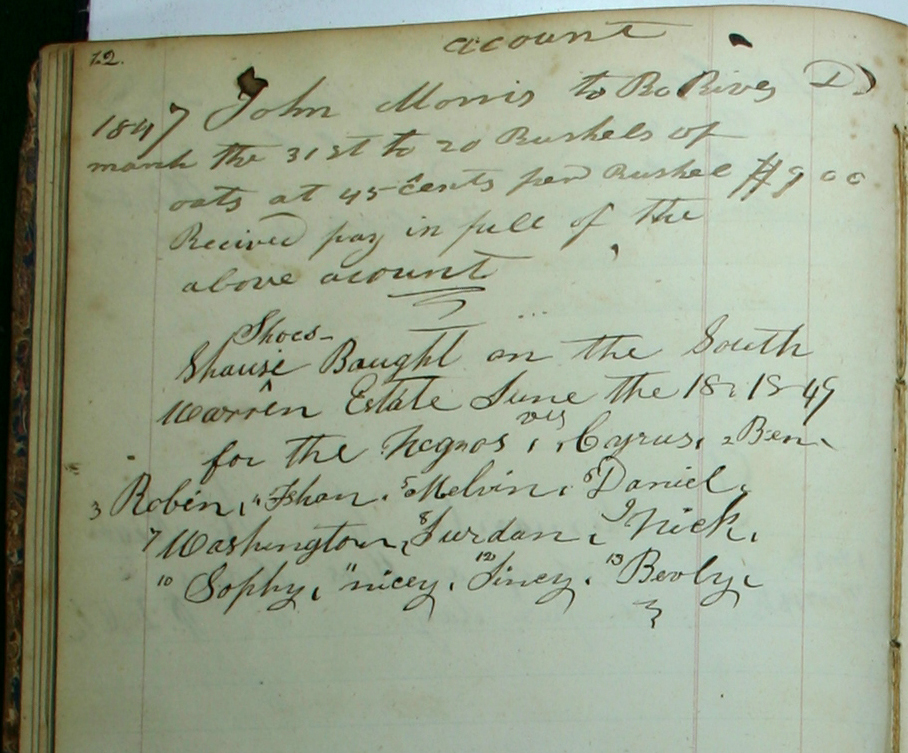
Entry from the business ledger of Robert Rives, Jr. Rives lists shoes that he purchased for some of his slaves. Among the names on the list are my great-great grandparents, Isham Rush and Nicey Ann Coles. (Robert Rives Ledger 1846-1863. Page 12, Image 8, Scottsville Museum, Scottsville Virginia)
The year 1851 was an eventful one for Nicey. In January 1851, she gave birth to Ella Rush, my great grandmother. Another document indicated that sometime later that year, she attempted to escape from South Warren.
Wait, my great-great grandmother ATTEMPTED TO ESCAPE!!!!!
A September 20, 1851 ledger entry made by Rives reveals that Nicey’s attempt was not successful: “Paid H.D. Robertson for the apprehension of Nicey and mileage there with $7.25.” I wondered at this series of events. Ella is listed in census records as the oldest of Nicey’s children. Perhaps there is a correlation between the two events–her pregnancy and her escape. But no documentation has been uncovered to support this.
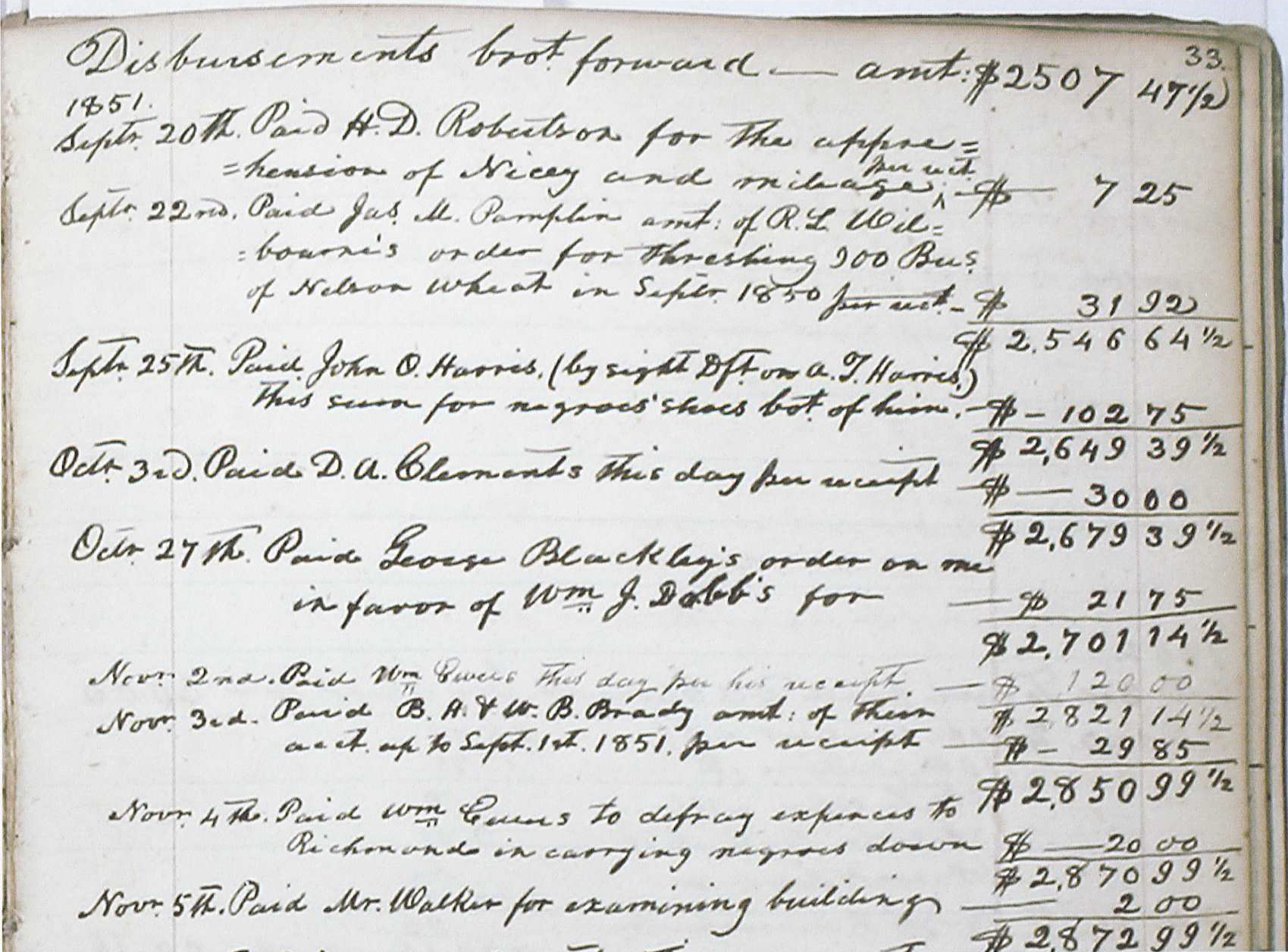
Nicey’s apprehension is documented on the second and third lines of this page. (Robert Rives Ledger 1846-1863. Page 33, Image 18, Scottsville Museum, Scottsville Virginia.)
Albemarle County Courthouse records helped me understand what happened to Nicey after the Civil War, and after Isham Rush disappeared from public record, presumably deceased. On September 18, 1868, Nicey and a man named Paul Moseley went to the Albemarle County Courthouse to obtain a marriage bond. Two days later, on September 20, 1868, they were married at the Chestnut Grove Church in Esmont, Virginia by a minister named Alexander White.
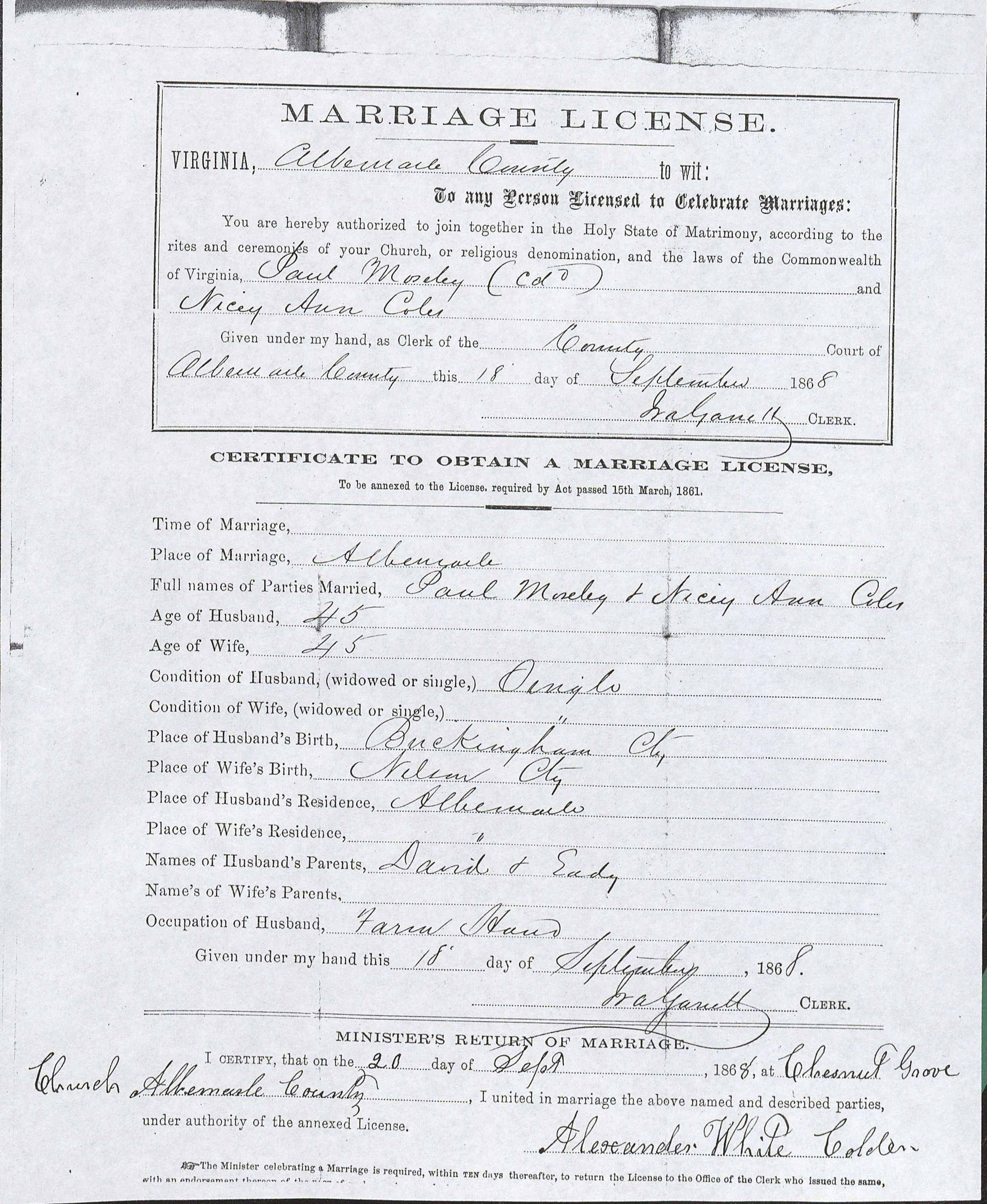
Marriage license of Nicey Ann Coles and Paul Moseley, September 18, 1868. Courtesy of the Albemarle County Courthouse, Charlottesville, Virginia, 22902 (Image by Regina Rush)
By 1870 Nicey was 47 years old, still residing in Warren, Virginia. She shared a home with her husband, 47-year-old Paul Moseley, her 12-year-old stepson Paul Jr., and all seven of her children. Ella, 20; Cecelia,18; Lucy, 16; Louisiana, 3; Isham, 13, Neverson, 11; Fleming, 7; and her granddaughter Sophronia, Ella’s 11-month-old daughter. The 1870’s saw Nicey’s daughters Cecelia and Lucy married and out on their own. Her son and step-son had either died or migrated to another area by 1880.
The 1880 census shows that Nicey and her family had moved to Scottsville, near to Cecelia. The census reveals that her husband was still alive and only three of her children remained in her household–Isham, Fleming, Louisiana. Nicey died sometime between 1880 and 1900.
From the first time I looked at the 1870 census record for the Rush line of my family, I felt compelled to learn their stories. Over more than fifteen years of digging into my family’s ancestry, I have amassed quite a bit of raw data that screams out to be put in some sort of form that tells their story. Notes from Under Grounds proved to be the perfect launching pad. It is my honor and privilege to tell the story of my great-great grandparents. I dedicate this blog post to them, the Patriarch and Matriarch of the Albemarle County Rushes of Chestnut Grove. World, I introduce to you Nicey Ann Coles and Isham Rush, my new friends.

Regina Rush Special Collections Reference Coordinator, March 26, 2014. She holds one of the Rives ledgers that has helped her recover her family history. (Photograph by Molly Schwartzburg)
Special thanks to the Scottsville Museum and the Albemarle County Courthouse for permission to share images from their collections.



Congratulations on finding part of your family and thank you for sharing your research – very interesting. Another thread of local history uncovered!
Melinda, thanks so much for reading my post and I really appreciate your kind comments.
Beautiful story!!!
Thanks Ophelia!
Well done Regina! I’m so glad your hard work and persistence paid off. It’s encouraging to know that there are records to be found about our ancestors that were slaves in this region.
Jennifer, I really appreciate your comments-they are so encouraging! You’re right, the records are out there we just need to ferret them out and give our ancestors a voice. Their stories are just waiting to be told.
What a touching story…and a wonderful tribute to your great-great grandparents. They would be so proud of you.
Chris, thank you for your comments, and for taking time to read my post!
Congratulations of finding such priceless history right under your feet. How touching to know you are the finder and the keeper of this rich Virginia legacy.
Thank you Colette for your comments and for the encouragement along the way.
Brent and Michelle – thanks again for sharing a part of your lives with us!I can barely see typing again – the tears of joy are filling my eyes!Much love and prayers as you begin another walk in deep fath!iJill
Fantastic!
Todd
Todd, Thank you for your comment and for taking the time to read my post.
Regina, what a lovely story. I know that your sleuthing has been hard, rewarding, and fun. I so enjoyed reading about your discoveries! Keep up the great work.
Margaret,
Thank you so much for sharing in my family’s history by reading my post.
Thanks so much for sharing this awesome journey with us which is serving as an inspiration for others to start their own search. My family and I are doing research also trying to unearth the MONROE and SCOTT BEGINNINGS. Continue the search. Congratulations!!!!!!
Thanks Ms. Eubanks! All the best with your research into your family’s history. I encourage you to make a trip to the Albert and Shirley Small Special Collections Library to research in our archives. Although not a genealogical library, we certainly have collections that might aid you in your research. Come check us out, I’ll be at the desk waiting for you(smile)!
Great job Regina, I enjoyed reading your family story.
Thanks Thelma!
How marvelous, I really admire the time and effort you have expended. Good luck with continued research. Gillian
Regina, this is a wonderful story! I enjoyed reading about your research–well done!
Thanks Christina!
Well done! Thanks for sharing the richness that binds your family together in a common bond. You’ve truly stirred a longing in my heart and soul to free the covered stories of my own ancestors whose mark and voices still lives on.
Continued blessings!
Barbara, thanks so much for your comments. I’m so glad my post has moved you to consider beginning your own genealogical journey. In the words of the late, great, Alex Haley,
‘My fondest hope is that ‘Roots” may start black, white, brown, red and yellow people digging back for their own roots. Man, that would make me feel 90 feet tall’
I echo Mr. Haley’s sentiment. That my blog post has inspired people to explore their family history makes me feel ’90 feet tall’ also and that’s saying something because I’m barely 5 feet.
Regina,
What a fascinating story and such impressive research into your family. As I well know, you are an excellent history scholar!
I hope that you will share this even more widely.
All best,
Ann Marie
thanks Regina rush for sharing this to me and everyone else I just started last week trying to search for my family need to know more about them my granddaddy was john ison rush and his mom was Roberta brooks rush and his dad was james rush. the reason I started doing this is because I have lived in this house in Charlottesville for about 3 years and I have neighbors and it took my uncle to come by to pick up a trailer that belongs to my dad to tell me you know the lady that just went in the house that lives next door to you she is your 2nd cousin and my mouth dropped but they are on my dads side not the rushes…. so again thank you for sharing this you just gave me more hope and drive to keep looking on both side of my family
Thanks Nashell!
Gina, this is such awesome work! I’m crying right now to just think of the lineage and how so much of our family history started so long ago. I took special note of the names that still float around in our family like my middle name “Neice” (I can never my middle name, lol) and the fact of the marriage at Chestnut Grove (CGB) so long ago and such a historic place for the spirituality and events (marriages and funeral) in our family. Again, great work book worm!
Thanks Denise! So glad you read the post. I can relate to the emotionalism. To think that we are standing on the shoulders of such strong people is humbling!
Excellent job! I enjoyed reading your article. I have been working on my own family history and know what it’s like to find that one clue that knocks down that wall into that past that you have been has been aching to discover. Wonderful job! Miss talking with you.
Renee, thank you so much for reading my post and for the kind comments you’ve written. I’m so glad you’re working on your family’s history! I would love to hear about your research at some point in the future. We should get together and compare notes!
What great discoveries. Congratulations!
Thanks Barbie!
Dear Regina,
Thank you for sharing your research and your family’s story. It is so thoughtfully written, it has me thinking of my own family’s history!
Jeanne
Jeanne, thanks for the comments!
A wonderful story, well told! I’m thrilled for you! I am currently working on a story about slaves emancipated from Moseley plantations in western Buckingham and Nelson County. Perhaps, I will bump into Paul Moseley.
Wonderful! Thanks for sharing and for all the help you have given me at Special Collections.
Thanks Edwina! Hope to see you in Special Collections again sometime soon.
Excellent research and a very moving story. My biography of William Cabell Rives (1793-1868) will be published soon. Much of my material came from UVa. Special Collections. During my research I discovered that Brown and Rives, the firm of Robert Rives, Sr. (father of W C Rives) engaged in slave trading among other enterprises. Page 243 of Alexander Brown’s The Cabells and Their Kin mentions slaves brought to Nelson from Sussex County after the death of Robert Rives’ parents in the early 1800s. Nelson County Will Book G, pages 123-139, lists an inventory of R Rives’ slaves, including a runaway. Thank you for telling this story, and I hope you continue your research.
Barclay, thank you for your comments! I’ve read portions of the book ‘The Cabells and Their Kin’, but unfortunately have not had time to follow up on it. The Nelson County Courthouse is next on my list of places to visit to research. Sigh, So Much Research, So Little Time(smile). Anyway, looking forward to reading your forthcoming biography on William Cabell Rives. Thank you so much for the additional information on Robert Rives and his slaves, I will definitely pursue these leads and see where they take me!
Take care and I’ll see you on your next visit to Special Collections.
Regina,
You’ve done a great job conveying the excitement of doing primary source research! Like other reference work, it is like putting together a puzzle. One piece leads to another and another and soon you start to see the bigger picture…
Thanks Melinda!
Fantastic blog post, Regina. It reinforces the importance of special collections libraries, such as the marvelous one at UVA, and the secrets they hold. I admire your archival skill in piecing together bits and pieces of your forebears’ lives, and also your narrative skill in presenting a compelling detective story. Thanks to you, the reader yearns to learn more about Nicey and Isham. We await the sequel!
Donna
Thanks so much for reading my post and for your very kind comments! Take care and I hope to see you sometime in the near future.
Gina, I was so very touched by your article….You go girl! Im so proud of you! :)….I want to do the same thing….its been in my spirit for years, but I hit a dead-end at the Historical Library in Richmond. Someone told me to check the archives in Washington D.C..Have you checked for anything there?….♥…And btw, youre looking Beautiful my sister! I love your hair!
Regina,
Congratulations on your success! What an accomplishment. I really enjoyed reading through your research. I started my journey visiting my ancestors two years ago and have since learned that my great-grandparents Jim and Louisa Jackson where both enslaved at Valmont at Scottsville, VA. The property was owned by the late Colonel Henry Gantt who led the Confederate 19th Army. Of course everything came to light with the 1870 census. I’m just amazed that they stayed on the farm with their eight children until the mid 1880’s when Henry Gantt died and the farm was lost. I’m curious about the relationship that existed between Gantt and my great-grand parents that they would have continued to work on the farm well after slavery ended. As a northerner, I always imagined that once the slaves were freed many left their former masters and moved north. Go figure. Again, great research. You have inspired me to continue on my journey through my past.
This article, along with the Scottsville Museum Newsletter version are very interesting. I have a suggestion. The Runaway Slave reward is made up of two amounts: (1) a fixed sum ($5 or $10, depending on whether the apprehension was 50 miles or less or more than 50 miles from the place of residence and (2) mileage at 10 cents a mile from place of apprehension to place of residence. I take it that the $7.25 payment represents a $5 fixed amount reward plus $2.25 for mileage. Putting aside the 5 cents amount, that puts the place of apprehension at 22 (say, 22 1/2) miles from South Warren/Oakland. A quick search reveals a Hugh D Robertson in the 1850 Census living in Nelson County. It is plausible (with an unknown probability) that this man could be the apprehender of Nicey. You might want to locate the Census record, identify where he was living and run the mileage. The best starting place for mileage is the corner of James River Road and Warren Ferry (the location of Oakland), running out along James River Road (the old Scottsville to Lynchburg Post Road) and on to wherever Mr Robertson was living (assuming he did not move from the 1850 census date to September 1851). It might be plausible that Nicey knew of underground railway connections in the direction of Nelson County or had some other hope of shelter in that direction and that the way towards all other points of the compass from Warren were not known to her. Best regards.
Thank you so much for posting your blog on your search for your great great grandparents, Nicey and Isham Rush. My husband and I moved to the area about 5 years ago and have had the pleasure of meeting some of the Rushes over the years. This area is steeped in history and it’s wonderful to know you’re keeping your family history alive and allowing us “newcomers” a peek into the history of the area.
Family is a wonderful thing and to “meet” our ancestors is a gift!
Regina, it’s very heartening to read about your family/research. I have always known you as a great writer, but I did not know that you are equally an excellent researcher. As always, very proud of you!
Thanks for sharing your story, it was amazing to read about a family that I know existed. Excellent research!!